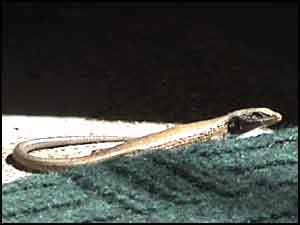Lizards
Northern Alligator Lizard Video Clips

Lizards are an important part of a balanced eco-system. This Northern Alligator Lizard, Elgaria coerulea (Gerrhonotus coeruleus), feeds on a variety of small invertebrates such as insects, ticks, spiders (including black windows), millipedes, snails and caterpillars.
Northern Versus Southern Alligator Lizards
The Southern Alligator Lizards have yellow eyes, longer tails, short legs and a well-defined fold on each side of its body. There are dark bands across the back and tail. The dark stripes on the belly go through the scales. Whereas, Northern Alligator Lizards are long bodied lizards with brown eyes, a shorter tail, longer legs and the dark stripes on the belly go between the rows of scales. Lizards, like snakes, shed their skin in one piece and will eat their shed.
Other differences between them is that the Southern lays eggs (oviparous) and the Northern is ovoviviparous, which means the fertilized eggs develop within the females and they retain the fertilized eggs inside their bodies until they are ready to hatch, thus giving the appearance of bearing "live young" (viviparous). I want to thank Heather Currey, an Interpretive Oregon State Park Ranger, for letting me know that Northern Alligator lizards are technically not viviporous as I originally thought but ovoviviparous. Because she is an Interpretive Park Ranger, she has two captive Northern Alligator lizards. During the month of September, 2008, one of them became a mother and had 5 baby Northern Alligator lizards. How cool is that!
Northern Alligator Lizard Habitat
The Northern Alligator Lizard loves cool and wet areas where rocks, rotten logs, loose bark, shrubs and other surface debris is readily available.
According to Living Landscapes, some individuals are site faithful, remaining in the same area (within 25 meter radius) for three consecutive years.
Northern Alligator Lizard Litters
These long-bodied, brown-eyed lizards mate in April at low elevations, in June in high elevations. They live about 8 years. Females reach sexual maturity in 32-44 months and produce one litter. Typically, there are four to six live young born in a litter.
Cinnabar Moth and Lizards
Unfortunately, here in Northwest, Coloherp.org reports that the introduced Cinnabar Moth (Tyria Jacobaeae) is causing a detrimental effect on lizards (and other vertebrate predators). The USGS distribution map, indicates the Cinnabar Moth is not yet in Lincoln County, Oregon. However, there are confirmed records in surrounding counties.
Amphibian Tunnels
Because amphibians and reptiles often travel across roads to breeding grounds, there is a movement to build these tunnels. Please take time to read the Canadian Amphibian and Reptile Conservation Network (CARCNET) article on Amphibian Tunnels for detailed information about this important step in preserving our sensitive amphibians and reptiles.
